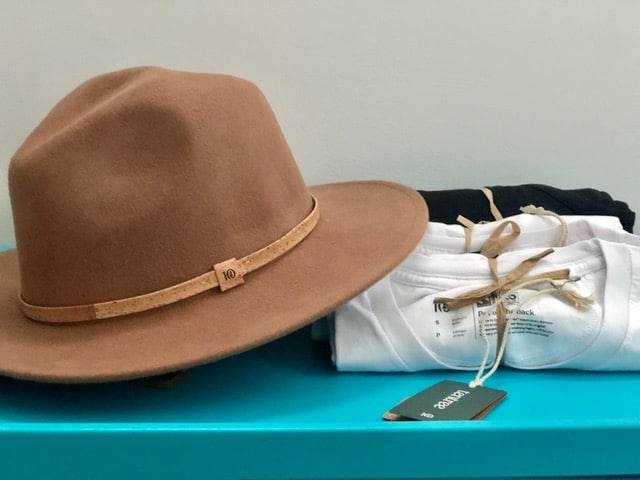6 ways to reduce your fashion footprint

One of our passion projects since Big and Lil S were born has been to live more sustainably. We hope by talking about the environment and incorporating sustainability into our daily lives, we’re raising a generation who will love and protect our Earth.
We’re still learning and figuring things out as we go, and there is a long list of projects that because of lifestyle, time, or money we haven’t tackled yet. But we thought we’d share a series on the small changes we’ve made over the years that have worked for us in striving for a more eco-friendly lifestyle. Whether it inspires you to try out some of these ideas, or to share the tips that work for you – the more love on the environment, the better!
We don’t need a handful of people doing zero waste perfectly. We need a million people doing it imperfectly. – Anne-Marie Bonneau, behind Zero-Waste Chef
Eco-friendly fashion.
This is probably one household area we struggle with the most. (It probably doesn’t make me sound very wise to start off with this one, but I just received a shipment of “basics” from Tentree, and I was excited to share why I am excited about it!)
I (Jaisy), am in charge of clothing for nearly everyone in the family. (I say nearly because occasionally Daniel runs out of socks and buys himself a pack on Amazon – which I can confidently say is probably NOT sustainable fashion.) Between two growing kids doing multiple sports/activities throughout all four seasons here in Canada, it’s a lot of STUFF we go through.
Here are 5 ways we’ve tried to reduce our fashion footprint (including what we’re still working on). They may be “old fashioned” ideas by now, but doing it creatively and consistently is key.
1) Reduce how much clothes we buy
This item mostly applies to us adults, as the kids cycle through their clothes almost once every season.
Neither Daniel or I subscribe to a rigorous closet decluttering method. We don’t have a “capsule wardrobe”. But neither of us buy much “fast fashion”, and we’re both paring down our wardrobe over time.
During the pandemic, Daniel switched to work-from-home, and I switched completely into scrubs. This has reduced how much we need to invest in work attire, as we both wear pretty much the same thing week after week.
We have a pretty minimalist aesthetic. For example, in the winter I wear leggings or jeans. In the summer I’m mostly in a jumpsuit (this is because I’m lazy and I can’t be bothered to coordinate). I buy these pieces in neutral patterns and invest in high quality items that last years. I have a jumpsuit that has shown up in photos of every travel destination for the last decade.





For occasion clothes, consider renting!
2) Repair
This is an area I definitely want to improve on. I have zero tailoring skills to speak of, and I am not proud of that fact. In fact, I tie sewing thread like a piece of suture. 🙈
BUT. I am starting to learn. I have learned to darn socks and wool clothing, and sew on loose straps, buttons, and patches. I’m at the point where it doesn’t embarrass me to wear something I’ve repaired in public, but I’m not certain how much more life I’m breathing into my clothes…
3) Reuse
We’re still working on the best way to reuse our old clothes. I’m really hoping one day I might be able to upcycle our old clothes, but that requires much more progress in the woeful tailoring department above.
Most of the kids’ cotton blends with holes in them become cleaning rags and staining rags for woodworking. Some of Daniel’s old dress shirts end up becoming art smocks for the kids. But the vast majority of our used clothes get…
4)… thrifted (recycle)
Second-hand fashion is the biggest fashion sustainability tactic in our house. It still satisfies my love of perusing and shopping, and is also budget friendly.
Things the kids (and I) outgrow generally get sold or given away. I try to sell some items on Facebook Marketplace or at our local consignment shop. Clothes and shoes that are in decent shape we also donate to our local thrift shops or drop off in clothing donation bins. Some of the kids’ pieces we’ve handed down to friends with younger kids.
About 75% of the kids clothing are preloved, mostly from second-hand children’s stores. Most of their everyday wear, their athletic wear (including Lil S’s ballet and gymnastics outfits and Big S’s soccer gear), and “holiday” outfits we buy from a second-hand shop near our house. I take the kids when possible, and they love it. They love the varied selection of clothes to choose from, and of course, the used toys and books! It was important for us to teach them not to turn their noses up at second-hand items, that someone’s “junk” may be someone else’s treasure. The only items we almost never buy used are shoes, because it’s hard to find good quality shoes.
The kids go to a school that requires uniforms. We donate the items they have outgrown to the school, and buy bigger pieces from their “used uniform sales”. This is both eco-friendly, and the school donates the proceeds to an educational program in Africa. Win-win.
I’d initially started buying second hand clothing for the kids, because they cycle through each size so quickly, but in recent years I’ve started shopping at consignment stores for myself. I haven’t decided if this is actually beneficial, because I don’t tend to wear these pieces nearly as much as the more carefully curated items I buy which better suit my style.
Lastly, don’t forget swapping! When Lil S was an infant, we received a giant box of baby girl clothing from friends of ours. When they had their second girl, we bundled it all up back up along with other pieces we acquired and returned it to them.
5) Sustainable shopping
As much as possible, we try to buy clothes we need from businesses with ethical and sustainable practices – clothes that are good for the environment, and produced in a way that is sustainable for those making the clothing.
I have to be honest, this is hard. I don’t always have time to study the companies and read where and how each piece is manufactured. Sometimes, we order from big box stores and department stores. But we do try, and once we find a company we like, we stick with it. We also try to support local businesses (or at least, Canadian businesses).
One of the companies we LOVE is TenTree, a company out of Vancouver, British Columbia. Not only do they make sustainable essentials using ethical business practices, they also plant 10 trees for every item purchased! This is why I was so excited about my package I ordered this year (all basics – t-shirts and a romper, 2 hats. My last TenTree cap blew out of our backpack when we were riding the mountain rollercoaster at Blue Mountain last summer.😢)
Another company I love to support is Cotopaxi. They’re not Canadian, but they are another company that makes both environmental and social sustainability a priority. And they make GREAT travel gear.
And for wintery activities that require a good merino wool base layer? Definitely shopping local for that!
6) Decrease wash wastage
Laundry is something that isn’t easily minimized with two active kids and lots of outdoorsy activities. While we’re not always able to decrease how many loads of laundry we do a week, we do try to decrease heat usage. We wash our loads with cold-cold water (there’s really no reason to use cold-warm or even hot cycles unless you are trying to sanitize something), and try to either air dry or tumble-dry on low heat.
We minimize laundry supply wastage. Replacing dryer sheets, in our opinion, is one of the easiest zero-waste things to do! Instead of sheets, use wool dryer balls. We’ve been using the same ones for years, and they’ve held up fine. For laundry detergent, we use the “Eco-Egg” (buy from Amazon or your local wellness store). The shell itself is plastic, but it uses ceramic pellets (some natural chemistry voodoo to get dirt off…) and refillable mineral cleaning pellets. It works just as well as detergent (although it doesn’t have that “clean” detergent smell), and anything eco-friendly that is non-inferior to its competitors is a win in my books. We like this, because we’ve had the same kit for over 3 years and haven’t had to replenish any of the pellets.
Alternative eco-friendly laundry detergents include laundry strips (less chemicals and packaging waste), and refillable or bulk laundry detergents. We are big fans of the Unscented Company in this house, and they make a bulk detergent that comes in a cardboard box.
Basically, 6 windy points later, I guess what we’re saying is we’re far from perfect in the sustainable fashion department. But we are always cognizant of our clothing choice impact, and getting better over time. Have tips on how to be more eco-friendly? Drop us a line!

